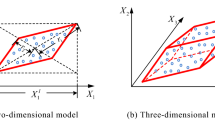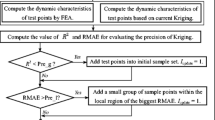Abstract
Computer models are widely used to simulate dynamic systems in automobile industry. It is imperative to have high quality CAE models with good predictive capability. This requires CAE engineers to conduct model calibration with physical tests. The challenges in the occupant restraint system model calibration are: (1) the dynamic system usually consists of multiple responses, (2) most of the responses are functional data or time histories, and (3) the traditional trial-and-error calibration approach is time consuming and highly depends on analyst’s expertise. These call for the development of an automatic and effective model calibration method. This paper presents a newly developed automatic model calibration method, based on the Error Assessment of Response Time Histories (EARTH) metric. The EARTH metric is used to perform model assessment on various important features of the functional responses. A new multi-objective optimization problem is formulated and solved by a Non-dominated Sorting Genetic Algorithm to automatically update CAE model parameters. A real-world example is used to demonstrate the use of the proposed method.







Similar content being viewed by others
References
Deb K, Agrawal S, Paratap A, Meyarivan T (2000) A fast elitism multi-objective genetic algorithm: NSGA-II. In: Proceedings of parallel problem solving from nature, Sprinter, pp 849–858
Fu Y, Abramoski E (2005) Robust design for occupant restraint system, SAE 2005-01-0814
Fu Y, Jiang X, Yang RJ (2009) Auto-correlation of an occupant restraint system model using a Bayesian validation metric. SAE 2009-01-1402
Fu Y, Zhan Z, Yang RJ (2010) A study of model validation method for dynamic systems. SAE 2010-01-0419
Jiang X, Mahadevan S (2007) Bayesian risk-based decision method for model validation under uncertainty. Reliab Eng Syst Saf 92(6):707–718
Jiang X, Mahadevan S (2008) Bayesian wavelet method for multivariate model assessment of dynamical systems. J Sound Vib 312(4–5):694–712
Jiang X, Yang RJ, Barbat S, Weerappuli P (2009) Bayesian probabilistic PCA approach for model validation of dynamic systems. SAE International Journal of Materials & Manufacturing 2(1):555–563
Kokkolaras M, Hulbert G, Papalambros P, Mourelatos Z, Yang RJ, Brudnak M, Gorsich D (2011) Towards a comprehensive framework for simulation-based vehicle systems design validation. Int J Veh Des
Lei H, Govindaraju V (2003) Synchronization of batch trajectory based on multi-scale dynamic Time Warping. In: Proceedings of the Second International Conference on Machine Learning and Cybernetics, Xi’an, 2–5 November 2003
Liu X, Fu Y, Chen W, Pass M (2005) Automated occupant model evaluation and correlation, IMECE2005-81258. In: Proceedings of 2005 ASME International Mechanical Engineering Congress & Exposition, November 5–11, 2005, Orlando, Florida
Mahadevan S, Rebba R (2005) Validation of reliability computational models using Bayes networks. Reliab Eng Syst Saf 87(2):223–232
NHTSA (2011) Hybrid III 50th Percentile Male, http://www.nhtsa.gov/Research/Hybrid+III+50th+Percentile+Male
Oberkampf WL, Barone MF (2006) Measures of agreement between computation and experiment: validation metrics. J Comput Phys 217(1):5–36
Rabiner LR, Huang BH (1993) Fundamentals of speech recognition, Prentice Hall
Rebba R, Mahadevan S (2006) Model predictive capability assessment under uncertainty. AIAA J 44(10):2376–2384
Sarin H, Kokkolaras M, Hulbert G, Papalambros P, Barbat S, Yang RJ (2008) A Comprehensive metric for comparing time histories in validation of simulation models with emphasis on vehicle safety applications. In: Proceedings of ASME International Design Engineering Technical Conference and Computers and Information in Engineering Conference (DETC’ 08), New York
Sarin H, Kokkolaras M, Hulbert G, Papalambros P, Barbat S, Yang RJ (2010) Comparing time histories for validation of simulation models: error measures and metrics. J Dyn Syst Meas Control 132(6):061401
TNO Automotive Safety Solutions (2010) Reference manual, MADYMO
Zhan Z, Fu Y, Yang RJ, Peng Y (2011a) An enhanced bayesian based model validation method for dynamic systems. J Mech Des 133(4):041005
Zhan Z, Fu Y, Yang RJ (2011b) Enhanced Error Assessment of Response Time Histories (EEARTH) metric and calibration process, SAE 2011-01-0245
Author information
Authors and Affiliations
Corresponding author
Rights and permissions
About this article
Cite this article
Zhan, Z., Fu, Y., Yang, RJ. et al. An automatic model calibration method for occupant restraint systems. Struct Multidisc Optim 44, 815–822 (2011). https://doi.org/10.1007/s00158-011-0671-6
Received:
Accepted:
Published:
Issue Date:
DOI: https://doi.org/10.1007/s00158-011-0671-6




